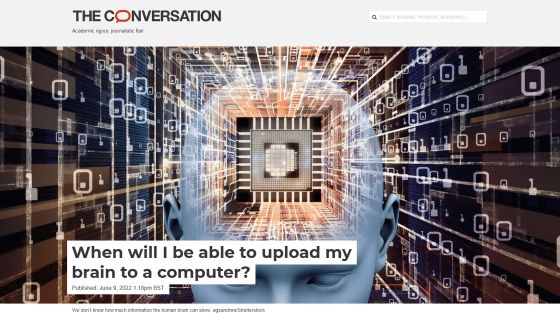Will the day come when you can 'upload' your brain to your computer and stay alive?

In the world of science fiction, the technology of transferring the human mind to a computer and keeping it alive forever as data or copying it to the body of a robot is sometimes drawn.
When will I be able to upload my brain to a computer?
https://theconversation.com/when-will-i-be-able-to-upload-my-brain-to-a-computer-184130

When you hear the discourse that 'human consciousness is caused by electrical signals in the brain,' you may feel that human consciousness can be easily transferred to a computer. In fact, a method of creating an accurate map of brain cells and brain connections by the method of 'slicing the brain thinly and scanning it with a high-resolution electron microscope' has also been devised, and research by the Allen Brain Science Institute in the United States has been devised. In 2019, the team succeeded in an experiment that 'cuts the brain of a 1 cubic millimeter mouse into 25,000 pieces and then scans it with an electron microscope to map the 3D structure of all neurons.'
In this experiment, the total number of images collected from the brain of a mouse of only 1 cubic millimeter was 100 million, and the number of recorded neurons was 100,000, reaching 1 billion synapses. The electron microscope has been in operation for 5 consecutive months, and the size of the completed data set has reached 2 petabytes (2 million gigabytes).
Since the human brain is said to have as many as 100 billion neurons, the time it takes to map 3D structures and the size of the datasets generated are not comparable to the 2019 experiment. Also, in order to make the operation of a computer resemble the brain, it is necessary to store these data in a random access memory (RAM) that can be accessed immediately instead of a large capacity HDD, but so far it has been equipped with such a large RAM. The computer is not built.
Also, this method requires the work of physically 'slicing the brain thinly', but it is very unlikely that humans will actually agree to slice the brain, and it will reach about 1260 cubic centimeters. It is almost impossible to slice the human brain accurately with readable accuracy.
In the first place, in order to slice the brain, the person must be dead, but the brain undergoes chemical changes immediately after it dies, and its structural and functional properties are not the same as those in life. Hmm. In addition, there is the challenge of 'uploading your brain when you're still relatively youthful at the age of 20, or when you're 80, when you have a lot of life experience?' You may have been convinced that uploading your brain will not be possible for some time to come. '

Furthermore, the biggest obstacle to the attempt to digitize brain activity is that 'after all, little is known about the underlying mechanism of brain activity.' Even if the complete structure of 100 billion neurons and their synapses can be reconstructed and stored and transferred to a computer, it is unknown how this works to be revived as a 'brain'.
Of course, some of the brain activities are being elucidated, such as the fact that neurons communicate with each other by local electrical changes and transmit information between neurons and via synapses. Still, it's not completely understood, and it's unclear how it applies to digitized neurons, so it's difficult to upload the brain to a computer and stay alive forever.

In addition, Thierry is skeptical of the very idea of 'I want to move my brain to a computer and stay alive.' He pointed out that he was dead when he sliced his brain, even if all the technical matters were resolved and the brain was literally copied to a computer to allow a complete simulation of brain function.
'Because living things such as humans and animals exist because they are alive.' 'A living mind inputs information from the world through sensations. It is a body that feels the world based on physical sensations. This causes physical changes such as changes in heart rate, breathing, and sweating that can be felt and contributed to the inner experience. Does it work like that? ', Thierry argues that the presence of only body and isolated brain data may not be life or conscious. Even if sensors and motor systems that provide sensory information are created, they will not be exactly the same as the actual body.
Thierry told anyone who wanted to upload their brain to a computer, 'I hope you have a long and healthy life. As long as it is done by your brain, your mind will definitely exist. , Continue to grow. May there be joys and dreams that androids never have. '

Related Posts:
in Science, Posted by log1h_ik







